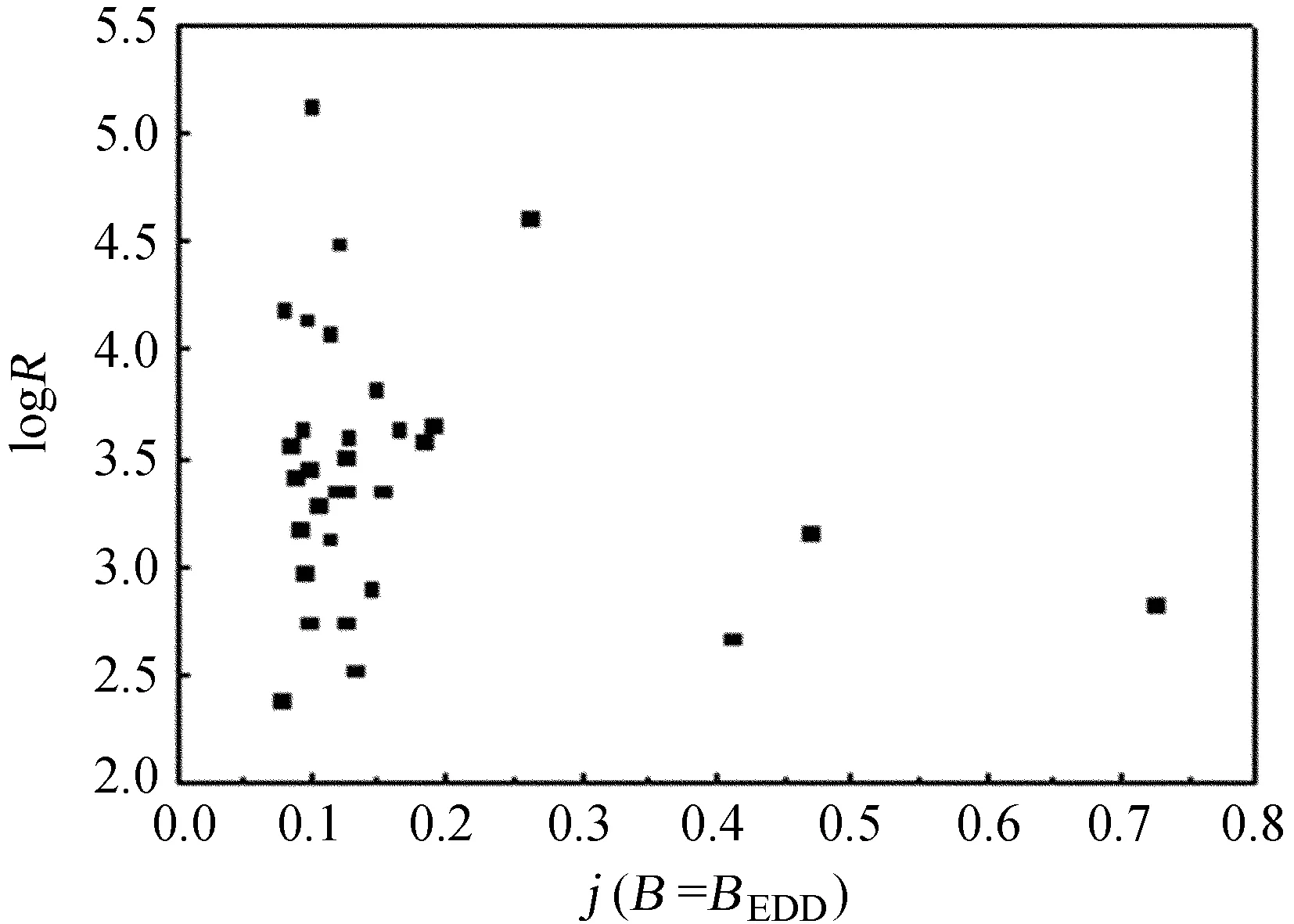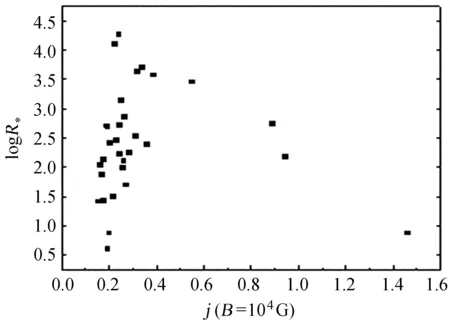射电类星体黑洞自旋与射电噪相关性研究*
2015-03-22张旭,张雄
张 旭,张 雄
(云南师范大学物理与电子信息学院,云南 昆明 650500)
射电类星体黑洞自旋与射电噪相关性研究*
张 旭,张 雄
(云南师范大学物理与电子信息学院,云南 昆明 650500)
黑洞自旋及其参量能提供射电类星体射电噪度的信息。从文献资料中收集了69个射电类星体源。这些源包含了37个陡谱射电类星体(SSRQs),32个平谱射电类星体(FSRQs)。通过样本数据研究黑洞自旋能量与射电类星体射电噪的相关性。研究结果表明:(1)37个陡谱射电类星体与射电噪存在明显的相关性。这种相关性在3种磁场条件下都存在(B=BEDD,B=104G,B∝j);(2)陡谱射电类星体与射电噪之间的相关性不受相对论聚束效应的影响;(3)32个平谱射电类星体与射电噪之间不存在相关性,这说明黑洞自旋与射电噪的相关性与射电类星体的类型有很大关系;(4)陡谱射电类星体黑洞自旋与射电噪的强相关性表明,黑洞自旋能量在一定程度上给出陡谱射电类星体射电噪度的信息。这些研究结果与其他人提出的理论是一致的。
射电类星体;黑洞自旋;射电噪;相关性
众所周知黑洞质量及寄主星系光度能反映射电类星体的射电噪度信息。近来Alexander*http://arxiv.org/abs/ 0810.1055对黑洞自旋进行了关于类星体射电噪与射电宁静的特征分歧是否由于其中心黑洞自旋的差异而产生的研究。要证明此理论需要讨论黑洞自旋与射电噪度是否存在必然的联系。
黑洞自旋和质量是类星体的两个基本物理量。黑洞自旋与射电类星体黑洞合并和吸积有着明显的关系,如文[1-6]均得出相同的结论。文[2]认为黑洞自旋和质量的变化在二元合并时是同时发生的。在合并的过程中黑洞的自旋速率会慢慢降低。文[4]认为大质量黑洞的吸积可能是由一系列连续随机的吸积事件组成,正是由于这些吸积事件使大质量黑洞具有中等的自旋。文[7]认为自旋及其参量与红移一样的功能,能对活动星系核(Active Galactic Nuclei, AGN)黑洞的合并与吸积特征进行精确的描绘。
大质量黑洞自旋的研究为大质量黑洞合并与吸积提供了全新的视角。现在有很多可行的方法估算大质量黑洞的自旋。例如当活动星系核吸积盘区域能观测到X射线时,可根据其辐射光谱的特性估算黑洞自旋[8]。又如当一个活动星系核拥有较强的喷流时,其喷流的特性也可用于估算活动星系核黑洞的自旋大小。正如文[9]总结的,当黑洞样本中有X射线辐射源或较强的喷流时能提供一个凭借经验估算黑洞自旋的途径。
在文[10-11]的模型中黑洞自旋能量与自旋在不同磁场下均存在紧密的联系。研究显示,黑洞自旋能量作为黑洞自旋的重要参量,其与红移之间同样存在相关性。文[5]认为,对自旋及其自旋能量的研究同红移一样,可以对黑洞的合并吸积特性进行精确的描绘。
本文运用BZ模型中黑洞自旋的关系式计算收集样本的自旋[6]的黑洞,其中包含了37个陡谱射电类星体(SSRQs),32个平谱射电类星体(FSRQs)。运用黑洞自旋的关系式计算自旋能量,讨论了不同类型的源在3种不同特性磁场下黑洞自旋与射电噪的相关特性。得出的结果表明Blazer黑洞自旋能量与红移存在较为直接的联系,这与Alexander得出的结论相同,表明黑洞自旋能量在一定程度上给出陡谱射电类星体射电噪度的信息。本文给出了用模型公式估算Blazer自旋能量大小的方法,为下一步自旋与射电类星体模型的研究提供了依据。
1 黑洞自旋及自旋能量的计算
1.1 黑洞自旋
计算黑洞自旋数据的方法与文[12]相同。在著名的BZ模型中电子束功率Lj的产生与自旋j的关系:
(1)
r为黑洞视界半径(r=2GM/c2);BP0为黑洞视界磁场强度;j≡Sc/(GM2);M8是以108M⊙为单位的黑洞质量;B4是以104G为单位的电磁场轴向分量强度。
在BZ模型中黑洞自旋与黑洞磁场强度的乘积可通过经验公式运用电子束功率Lj及黑洞爱丁顿光度近似表达:
(2)

.
(3)
当黑洞喷流较强时用这种方法估算黑洞自旋比较准确[12]。这种方法基于喷流较强时其自旋能量与旋转的黑洞周围区域的吸积物质有关的标准模型[13-15]。由于喷流及自旋的数值很大,可以忽略黑洞自旋及磁场强度对其关系的影响。黑洞自旋与喷流电子束关系模型中,磁场强度和黑洞质量通常被设定为常数[16-17]。它们有如下关系[18-21]:
Lj∝j2M2B2,
(4)
Lj为黑洞喷流电子束功率;M是黑洞质量;j为黑洞自旋量j=a/m,a=S/(Mc),m=GM/c2;S为黑洞自旋的角动量大小;c为光速;B为吸积盘和黑洞的电磁场轴向分量的强度。由此算出黑洞自旋量j的值[21-22]:
j=k(L44)0.5B4-1M8-1,
(5)

本文引入了3种不同的磁场条件,即爱丁顿磁场、静磁场和与自旋有关的磁场,这3种磁场分别与黑洞的参数有联系。能量密度与爱丁顿极限下的磁场定义为爱丁顿磁场,爱丁顿磁场以104G为单位,BEDD≌6M8-1/2[21,24],这种磁场是基于在爱丁顿光度下的辐射源检测出的,文[25]认为很多活动星系核的辐射均在此光度下。为了鉴定爱丁顿磁场特性的影响,引入静磁场,磁场强度以104G为单位,B4=1[18,23,25]。作为对比引入自旋磁场,如果黑洞的自旋能量是连续的,射电星系的磁场强度与自旋成比例关系以104G为单位,B4≌2.78j[21,26-27]。在Meier的hybrid模型及Allen的经验推论中均表明磁场强度与自旋存在某种联系(B∝j)[28-30],与自旋有关的磁场计算出的黑洞自旋能作为黑洞自旋与射电噪的相关性研究良好的参考项。
2 实验结果
由于本文的计算方法与文[12]相同,为了保证分析结果的准确性,故采用与文[12]相同的流量样本采集方案。从文献中采集了69个具有准确喷流能量数据的射电类星体源,样本计算黑洞自旋所需要的178 MHz流量密度L44(以央斯基为单位)均来源于NASA/IPAC河外星系数据库。
采集的射电类星体样本数据包括红移、黑洞质量、178 MHz流量密度、射电噪度R、消除相对论聚束效应影响的射电噪R*。射电类星体的射电噪测定很大程度上受无线电及光学波段的相对论聚束效应的影响,这对于平谱射电类星体尤其明显。为了消除这种影响,引用核心射电光度替代热光度测定射电类星体射电噪。运用这种方法所得的射电噪数据,将其定义为消除相对论聚束效应影响的射电噪R*。
运用(5)式分别计算了在3种不同的磁场条件下黑洞自旋以及自旋能量,以上数据均列于表1中。本文着重讨论黑洞自旋与射电类星体射电噪的相关性。本文数据按源IAU名称由小到大排列。

表1 黑洞红移质量自旋及射电噪度

续 表
注1:表中(1)源; (2)类型; (3)红移; (4)151 MHz下的流量密度来源于河外星系网络数据库; (5)黑洞质量; (6)爱丁顿磁场条件下的自旋; (7)静磁场条件下的自旋; (8)B∝j条件下的自旋Refs文献: B94b[31]: Brotherton et al. (1994). B96[32]: Brotherton (1996). C91[33]: Corbin (1991). C97[34]: Corbin (1997). CJ01[35]: Gu & Jiang et al. (2001). G01[36]: Gu et al. (2001). H02[37]: Garrington et al. (1991). L96[38]: Lawrence et al. (1996). M96[39]: Marziani et al. (1996). M99[40]: McIntosh et al. WB86[41]: Wills & Browne (1986)
由图1~3可以看出黑洞自旋在3种不同的磁场条件下与陡谱射电类星体射电噪R具有较高的相关性。说明黑洞自旋与陡谱射电类星体射电噪之间存在联系,且这种联系在多种磁场条件下都成立。同时表明黑洞自旋在一定程度上给出陡谱射电类星体射电噪度的信息。
由图4~6消除相对论聚束效应影响后的射电噪度R*同样与不同磁场条件下的黑洞自旋有着几乎同样高的相关性。说明黑洞自旋与陡谱射电类星体射电噪之间的联系不受寄主星系影响。再次印证了黑洞自旋在一定程度上反应陡谱射电类星体射电噪度的信息。

图1 陡谱射电类星体黑洞自旋j与logR的相关性(B=BEDD)Fig.1 The statistical correlation between black hole spin values and logR of SSRQs (under the assumption B=BEDD)

图2 陡谱射电类星体黑洞自旋j与logR的相关性(B=104G)Fig.2 The statistical correlation between black hole spin values and logR of SSRQs (under the assumption B=104G)

图3 陡谱射电类星体黑洞自旋j与logR的相关性(B∝j)Fig.3 The statistical correlation between black hole spin values and logR of SSRQs (under the assumption B∝j)

图4 陡谱射电类星体黑洞自旋j与logR*的相关性(B=BEDD)Fig.4 The statistical correlation between black hole spin values and logR* of SSRQs (under the assumption B=BEDD)

图5 陡谱射电类星体黑洞自旋j与logR*的相关性(B=104G)Fig.5 The statistical correlation between black hole spin values and logR* of SSRQs (under the assumption B=104G)

图6 陡谱射电类星体黑洞自旋j与logR*的相关性(B∝j)Fig.6 The statistical correlation between black hole spin values and logR* of SSRQs (under the assumption B∝j)
由图7~12可以看出黑洞自旋在3种不同的磁场条件下与平谱射电类星体射电噪几乎不具有相关性。说明黑洞自旋与平谱射电类星体射电噪之间并不存在类似陡谱射电类星体的联系,且这种联系在多种磁场条件下都不成立。表明黑洞自旋在一定程度上给出陡谱射电类星体射电噪度的信息。同时也表明黑洞自旋与射电类星体射电噪度的相关性与射电类星体的类型有关。

图7 平谱射电类星体黑洞自旋j与logR的相关性(B=BEDD)Fig.7 The statistical correlation between black hole spin values and logR of FSRQs (under the assumption B=BEDD)

图8 平谱射电类星体黑洞自旋j与logR的相关性(B=104G)Fig.8 The statistical correlation between black hole spin values and logR of FSRQs (under the assumption B=104G)

图9 平谱射电类星体黑洞自旋j与logR的相关性(B∝j)Fig.9 The statistical correlation between black hole spin values and logR of FSRQs (under the assumption B∝j)

图10 平谱射电类星体黑洞自旋j与logR*的相关性(B=BEDD)Fig.10 The statistical correlation between black hole spin values and logR* of FSRQs (under the assumption B=BEDD)

图11 平谱射电类星体黑洞自旋j与logR*的相关性(B=104G)Fig.11 The statistical correlation between black hole spin values and logR* of FSRQs (under the assumption B=104G)

图12 平谱射电类星体黑洞自旋j与logR*的相关性(B∝j)Fig.12 The statistical correlation between black hole spin values and logR* of FSRQs (under the assumption B∝j)
3 结 论
由于陡谱射电类星体及平谱射电类星体的样本数量较少,可能对黑洞自旋与射电噪的相关性分析产生一定的误差。要进一步详细探讨黑洞自旋与陡谱射电类星体射电噪的相关性以及测定自旋与射电噪的关系公式,就需要更多的观测数据验证本文的研究结果。
表2为不同条件下黑洞自旋与射电噪度的相关性数据。由表2可以看出黑洞自旋与陡谱射电类星体射电噪度之间存在较高的相关性,这种相关性在3种不同的磁场条件下均成立,而且实验的相关性结果并不受消除相对论聚束效应影响。但平谱射电类星体的样本中却没有显现明显的相关性,这可能表明黑洞自旋与射电类星体射电噪度的相关性与射电类星体的类型有关。

表2 不同条件下黑洞自旋与射电噪度的相关性数据
由于黑洞自旋与陡谱射电类星体射电噪度的相关性,可推断黑洞自旋能量能如同黑洞质量及寄主星系的光度一样可以对射电噪类星体的射电噪度进行一定的描绘。
[1] Hughes A H, Blandford R D. Black hole mass and spin coevolution by mergers [J]. The Astrophysical Journal Letters, 2003, 585(2): L101-L104.
[2] Volonteri M, Rees M J. Rapid growth of high-redshift black holes [J]. The Astrophysical Journal, 2005, 633(2): 624-629.
[3] King A R, Pringle J E. Fuelling active galactic nuclei[J]. Monthly Notices of the Royal Astronomical Society, 2007, 385(3): 1621-1627.
[4] Volonteri M, Sikora M, Lasota J P. Black hole spin and galactic morphology[J]. The Astrophysical Journal, 2007, 667(2): 704-713.
[5] Berti E, Volonteri M. Cosmological black hole spin evolution by mergers and accretion[J]. The Astrophysical Journal, 2008, 684(2): 822-828.
[6] Zhang S N, Cui W, Chen W, et al. Black hole spin in X-ray binaries: observational consequences[J]. The Astrophysical Journal, 1997, 482(2): L155-L158.
[7] McClintock J E, Narayan R, Steiner J F. Black hole spin via continuum fitting and the role of spin in powering transient jets[J]. Space Science Reviews, 2013(1): 256-258.
[8] Steiner J F, McClintock J E. Measuring black-hole spin and modeling the jet dynamics in microquasar XTE J1550-564[J]. Monthly Notices of the Royal Astronomical Society, 2011, 416 (1): 941-946.
[9] Meier D L. Simulations of relativistic jet formation[J]. The Astrophysical Journal, 1999, 35(5): 522-753.
[10]Blandford R D. Spectrum of a radio pulse from an exploding black hole[J]. Monthly Notices of the Royal Astronomical Society, 1977, 181(2): 489-498.
[11] Schmoll S, Miller J M, Volonteri M, et al. Constraining the spin of the black hole in Fairall 9 with Suzaku[J]. The Astrophysical Journal, 2009, 703(2): 2171-2176.
[12] Daly R A. Estimates of black hole spin properties of 55 sources[J]. Monthly Notices of the Royal Astronomical Society, 2011, 414(2): 1253-1262.
[13]Reynolds C S, Garofalo D, Begelman M C, et al. Trapping of magnetic flux by the plunge region of a black hole accretion disk[J]. The Astrophysical Journal, 2006, 651(2): 651-1023.
[14]Tatum M M, Turner T J, Miller L, et al. The global implications of the hard X-ray excess in type 1 AGN[J]. The Astrophysical Journal, 2012, 762(2): 80.
[15]Tchekhovskoy A, Narayan R, McKinney J, et al. Efficient generation of jets from magnetically arrested accretion on a rapidly spinning black hole[J]. Monthly Notices of the Royal Astronomical Society, 2011, 418(1): L79-L83.
[16]Thorne R M, Shprits Y Y, Meredith N P, et al. Refilling of the slot region between the inner and outer electron radiation belts during geomagnetic storms [J]. Journal of Geophysical Research: Space Physics, 2007, 112(A6): 1-11.
[17]Nardini E, Fabian A C, Walton D J, et al. Investigating the reflection contribution to the X-ray emission of Ton S180[J]. Monthly Notices of the Royal Astronomical Society, 2012, 423(4): 3299-3307.
[18]Zoghbi A, Fabian A C, Uttley P, et al. Broad iron L line and X-ray reverberation in 1H0707-495 [J]. Monthly Notices of the Royal Astronomical Society, 2010, 401(1): 2419-2432.
[19]Fender R P, Belloni T M, Gallo E, et al. Towards a unified model for black hole X-ray binary jets[J]. Monthly Notices of the Royal Astronomical Society, 2004, 355(4): 1105-1118.
[20]Daly R A. Bounds on black hole spins[J]. The Astrophysical Journal Letter, 2009, 696(1): 691-L72.
[21]Narayan R, McClintock J E. Observational evidence for a correlation between jet power and black hole spin [J]. Monthly Notices of the Royal Astronomical Society, 2011, 419(1): L69-L73.
[22]Komossa S. Observational evidence for supermassive black hole binaries[C]// AIP Conference Proceedings. 2013.
[23]Dermer C D, Finke J D, Menon G, et al. Black-hole engine kinematics, flares from PKS 2155-304, and multiwavelength blazar analysis[J]. The Astrophysical Journal, 2008, 10(1): 810-1055.
[24]Rees M J. Black hole models for active galactic nuclei[J]. Annual Review of Astronomy and Astrophysics, 1984, 22(1): 471-506.
[25]King A R. Black hole outflows[J]. Monthly Notices of the Royal Astronomical Society, 2010, 402(1): 1516-1522.
[26]Emmering R T, Blandford R D, Shlosman I, et al. Magnetic acceleration of broad emission-line clouds in active galactic nuclei[J]. The Astrophysical Journal, 1992, 385: 460-477.
[27]Punsly B, Coroniti F V. Relativistic winds from pulsar and black hole magnetospheres[J]. The Astrophysical Journal, 1990, 350(2): 518-535.
[28]Daly R A, Guerra E J. High-redshift radio galaxies as a cosmological tool exploration of a key assumption and comparison with supernova results[C]// AIP Conference Proceedings. 2002.
[29]Allen S W, Dunn R J H, Fabian A C, et al. The relation between accretion rate and jet power in X-ray luminous elliptical galaxies[J]. Monthly Notices of the Royal Astronomical Society, 2006, 372(1): 21-30.
[30]Merloni A, Heinz S. Measuring the kinetic power of active galactic nuclei in the radio mode[J]. Monthly Notices of the Royal Astronomical Society, 2007, 381(2): 589-601.
[31]Brotherton M S, Wills B J, Steidel C C, et al. Statistics of QSO broad emission-line profiles. 2: the C IV wavelength 1549, C III) wavelength 1909, and MG II wavelength 2798 lines[J]. The Astrophysical Journal, 1994, 423: 131-142.
[32]Brotherton M S. The profiles of H beta and [O iii] lambda 5007 in radio-loud quasars[J]. The Astrophysical Journal Supplement Series, 1996, 102(1): 1-27.
[33]Corbin M R. The emission-line properties of steep radio spectrum quasars [J]. The Astrophysical Journal, 1991, 375(2): 503-516.
[34]Corbin M R. The emission-line properties of low-redshift quasi-stellar objects. II. the relation to radio type [J]. The Astrophysical Journal Supplement Series, 1997, 113(2): 245-267.
[35]Gu M F, Cao X W, Jiang D R, et al. On the masses of black holes in radio-loud quasars[J]. Monthly Notices of the Royal Astronomical Society, 2001, 327(4): 1111-1115.
[36]Gu Q S, Huang J H, de Diego J A, et al. The nuclear starburst activity in the Seyfert 2 galaxy NGC 7679[J]. Astronomy and Astrophysics, 2001, 374(3): 932-935.
[37]Garrington S T, Conway R G, Leahy J P, et al. Asymmetric depolarization in double radio sources with one-sided jets[J]. Monthly Notices of the Royal Astronomical Society, 1991, 250(1): 171-197.
[38]Afanas’ev V L, Dodonov S N, Moiseev A V, et al. Radio and optical spectra of objects from three complete samples of radio sources[J]. Astronomy Reports, 2006, 50(4): 255-272.
[39]Marziani P, Sulentic J W, Dultzin H D, et al. Comparative analysis of the high-and low-ionization lines in the broad-line region of active galactic nuclei[J]. Monthly Notices of the Royal Astronomical Society, 1996, 104(1): 37-70.
[40]McIntosh D H, Rix H W, Rieke M J, et al. Redshifted and blueshifted broad lines in luminous quasars[J]. The Astrophysical Journal Letters, 1999, 517(2): L73-L76.
[41]Wills B J, Browne IWA. Relativistic beaming and quasar emission lines[J]. The Astrophysical Journal, 1986, 302(1): 56-63.
An Analysis of Statistical Correlations between Black Hole Spin Values and Radio-Loudness Indices in Radio Loud AGN
Zhang Xu, Zhang Xiong
(School of Physics and Electronic Information Technology, Yunnan Normal University, Kunming 650500, China, Email: ynzx@yeah.net)
We have collected a sample of 69 radio-loud quasars from various
. The sample includes 37 SSRQs (withα>0.5) and 32 FSRQs (withα<0.5) with redshifts ranging from about zero to about two. We have carried out an analysis of statistical correlations between black hole spin values and radio-loudness indices for the sample. In the analysis we consider three cases of the spin values. The three cases correspond to three different assumptions about the magnetic field strengths around the black holes. Our conclusions are as follows. (1) In SSRQs their black hole spin values are strongly correlated with their radio-loudness indices; (2) The correlation in SSRQs is not caused by relativistic beaming; (3) There is no indication of a strong correlation between supermassive black hole mass values and spin values for FSRQs; (4) The correlations between black hole spin values and radio-loudness indices may be different for different types of radio-loud quasars. Our results are consistent with models of radio-loud quasars of other authors.
Radio-loud quasars; Black-hole spin; Radio loudness; Correlation
国家自然科学基金 (U1231203, 11063004);云南省自然科学基金 (2010CD046) 资助.
2014-12-02;修定日期:2014-12-28
张 旭,男,硕士. 研究方向:黑洞,活动星系核. Email: 2226997466@qq com
张 雄,男,教授. 研究方向:黑洞,活动星系核. Email: ynzx@yeah net
P158
A
1672-7673(2015)04-0394-09
CN 53-1189/P ISSN 1672-7673
